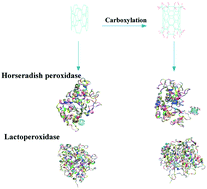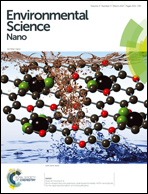Understanding enzymatic degradation of single-walled carbon nanotubes triggered by functionalization using molecular dynamics simulation
Abstract
Enzymes are promising candidates for removing environmental carbon nanotubes (CNTs). However, pristine CNTs are difficult to degrade by plant or animal enzymes, such as horseradish peroxidase (HRP) and lactoperoxidase (LPO), and functionalization is often needed for CNT biodegradation. By constructing 12 systems comprising two well-known CNT-degrading enzymes (HRP and LPO) with or without carboxylated or pristine single-walled CNTs (SWCNTs), we answer questions as to how functionalization changes the energetic properties and enzymatic conformations to facilitate the occurrence of SWCNT degradation and how these analysed enzymes respond to different carboxylated SWCNTs using molecular dynamics (MD) simulations. Significant conformational changes in the enzymes were found after the SWCNTs were carboxylated, and functionalization improved the structural stability of enzyme–substrate complexes. Numerous carboxylated SWCNTs induced a similar variation trend of global conformations for both HRP and LPO at the late stages, but their cavity volumes showed totally different change patterns with time. Our study provides a molecular-level understanding of functionalization's roles in SWCNT biodegradation and a molecular basis to develop more biocompatible and biodegradable CNTs.


 Please wait while we load your content...
Please wait while we load your content...